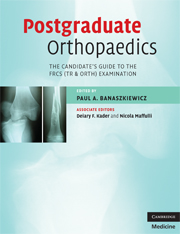Book contents
- Frontmatter
- Contents
- List of contributors
- Foreword by Mr Peter Gibson
- Preface
- Glossary
- Section 1 The FRCS (Tr & Orth) examination
- Section 2 The written paper
- Section 3 The clininicals
- 3 The short cases
- 4 Short case list
- 5 The long cases
- 6 Long case list
- 7 Hand and wrist clinical cases
- 8 Shoulder and elbow clinical cases
- 9 Spine clinical cases
- 10 Hip clinical cases
- 11 Knee clinical cases
- 12 Foot and ankle clinical cases
- 13 Paediatric clinical cases
- Section 4 Adult elective orthopaedics oral
- Section 5 The hand oral
- Section 6 The paediatric oral
- Section 7 The trauma oral
- Section 8 The basic science oral
- Section 9 Miscellaneous topics
- Index
9 - Spine clinical cases
from Section 3 - The clininicals
Published online by Cambridge University Press: 22 August 2009
- Frontmatter
- Contents
- List of contributors
- Foreword by Mr Peter Gibson
- Preface
- Glossary
- Section 1 The FRCS (Tr & Orth) examination
- Section 2 The written paper
- Section 3 The clininicals
- 3 The short cases
- 4 Short case list
- 5 The long cases
- 6 Long case list
- 7 Hand and wrist clinical cases
- 8 Shoulder and elbow clinical cases
- 9 Spine clinical cases
- 10 Hip clinical cases
- 11 Knee clinical cases
- 12 Foot and ankle clinical cases
- 13 Paediatric clinical cases
- Section 4 Adult elective orthopaedics oral
- Section 5 The hand oral
- Section 6 The paediatric oral
- Section 7 The trauma oral
- Section 8 The basic science oral
- Section 9 Miscellaneous topics
- Index
Summary
Ankylosing spondylitis
Introduction
This is classic long case material. There are good clinical signs present with a lot to talk about and discuss afterwards with the examiners.
Memorandum
On general inspection we have a male patient who is somewhat stooped as he walks into the room. On examination from behind the shoulders are of equal height, there is loss of normal lumbar lordosis, a fixed kyphosis of his thoracic spine and a forward thrust of his cervical spine. From the front his head appears to be translated forwards but his visual axis is just about horizontal. His pelvis is level but he tends to stand with a slightly flexed attitude of his hips and knees.
On examination of his neck movements there was very limited flexion and extension present. There is almost no lateral movement of his cervical spine. Examining his lumbar spine reveals a gross restriction of all movements. In particular he tends to flex his hips when bending forwards to compensate for a stiff spine.
The patient has a classic question mark posture with pronounced thoracolumbar kyphosis and flexion deformities of the hip.
Schober's test for lumbar forward flexion was 3 cm (normal=5 cm or more), which is markedly reduced. The wall test unmasks a flexion deformity of the spine. He is unable to stand with his back flush against the wall. Forced flexion, abduction and external rotation of the hip joint (Faber test) produces severe pain of the sacroiliac joints.
Maximum chest expansion from full expiration to full inspiration measured at the level of the nipples is reduced to 3 cm compared to a normal expansion of 7 cm.
- Type
- Chapter
- Information
- Postgraduate OrthopaedicsThe Candidate's Guide to the FRCS (TR & Orth) Examination, pp. 64 - 70Publisher: Cambridge University PressPrint publication year: 2008



